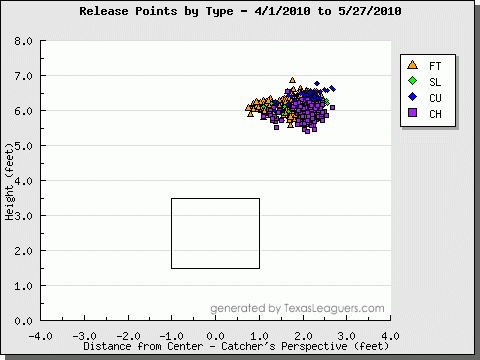Is Something Wrong With Ryan Rowland-Smith?
Entering the 2010 season, the Mariners starting pitching was a question mark. After Cliff Lee was sidelined early in Spring Training with an abdominal strain, the bottom half of the rotation came under further scrutiny. As the Mariners evaluated questionable candidates for the bottom half of the rotation, fans and the front office could at least rest easy thatFelix Hernandez and Ryan Rowland-Smith were healthy and prepared to start.
What a difference forty days can make. Doug Fister and Jason Vargas have been among the few pleasant surprises in Seattle this season, while RRS has seemingly lost the confidence of the coaching staff. Last night, RRS gave up two more long balls and he was removed in the bottom of the third inning. It was his second start in a row he did not record an out in the third inning.
It isn’t difficult to see that Rowland-Smith has been struggling. He hasn’t pitched into the seventh inning since April 17th, and hasn’t made it to the sixth in three starts. He’s allowed ten home runs in thirty-nine innings while walking more men than he’s struck out (17-16.) All of this leads to a gruesome 7.15 FIP and a troublesome 5.91 xFIP. Furthermore, 25% of balls put in play against Rowland-Smith have been line drives, leading to a9.10 tRA.
He’s also having a problem generating swinging strikes. It isn’t that he is having control issues; he’s throwing strikes at virtually the same percentage this year as he was last season. His problem is generating swinging strikes, particularly on pitches out of the strike zone. Last year, hitters made contact on 69.3% of pitches they swung at outside of the strike zone. This year, that number has climbed all the way to 78%. This would explain his inability to strike people out, as he can’t lure batters to swing at good pitches out of the zone.
Considering the high xFIP, tRA, and contact rate on balls outside of the strike zone, one has to wonder if there is some hidden problem in his game. My best guess would be that something is wrong with his fastball. Last year his heater was 4.4 runs above average. This season, his fastball has been worth -6.6 runs below an average offering. Let’s look a little deeper.
In 2009, Rowland-Smith worked almost exclusively with a four seam fastball (when throwing fastballs of course.) This year, all of his fastballs have been two-seamers. Perhaps the adjustment from four-seamers to two-seamers has been part of the problem. Though his fastball velocity down only a tick, hitters are really teeing off against it.
I’ve pored through his pitch F/x data, looking for some differences between his pitches this year and last year. The most striking difference between the two years I can find is his struggle to find a consistent release point this year. Take a look at the difference between 2010 and last season. (Pitch f/x data is courtesy of Texas Leaguers.)


RRS has particularly had trouble with consistently releasing his two seam fastball. I’m not sure if an inconsistent release point is responsible for his struggles this year, but this is something to monitor over his next couple of outings. He’s releasing his two-seamer closer to the strike zone than the other two pitches, which could explain why hitters, and lefties in particular, are seeing the ball better than they did last year. His two-seamer doesn’t have much movement, and perhaps the lack of movement, slightly reduced velocity, and limited horizontal movement have turned his heater into a poor pitch.
I can’t be sure that RRS’s release point issues are the cause of his poor performance to date in 2010. At the same time, I would like to see him become more consistent with his release point. If he corrects that flaw and is still struggling, we can re-examine his case. Until then, I’m assuming that he’s releasing his fast-ball on a more over the top plane than his other pitches, and that is either causing it to break less or is tipping off hitters.